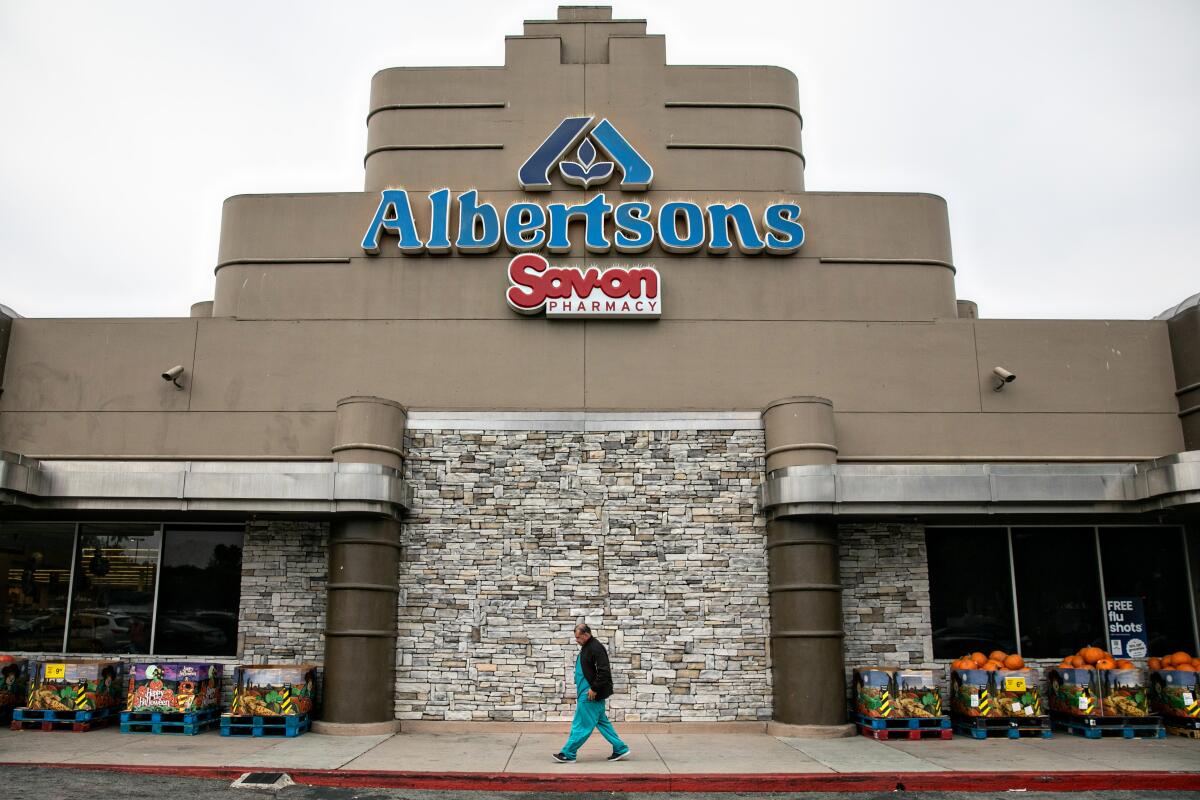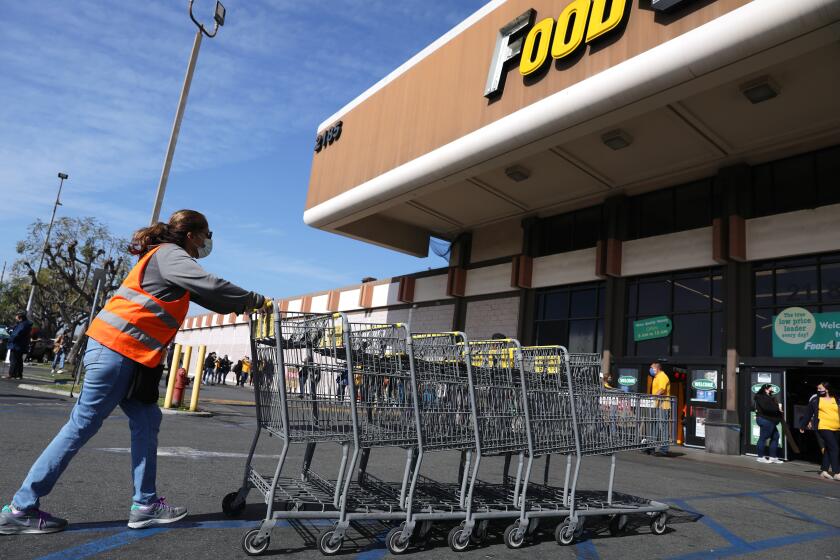Op-Ed: The grocery chain wars prove that the modern supermarket model isn’t sustainable

- Share via
When grocery giants Kroger and Albertsons announced plans for a $24.6-billion merger last week, my first reaction was a monster movie: Godzilla and Mothra lumbering toward an awful love. Two corporate reptiles ready to wreck the city almost incidentally as they consummate their bottom line.
This new mega-grocer would immediately corner 19% of the market, pulling in $200 billion per year, controlling 5,000 stores, 50 manufacturing centers and the careers of over 700,000 workers. To put that size in perspective, in 1944, when the “Great A&P” held just a 10% share of the grocery market, the government moved to break it up.
But it’s not 1944. Which is why my disaster movie reaction doesn’t tell the whole story.
Today, with or without this merger, Walmart has already captured a whopping 27% of the market. Costco has another 9%. And Amazon, the small guy for once, is aggressively threatening everyone in the sector. Incredible as it might seem, from Kroger and Albertsons’ perspective, this merger probably feels existential. If they aren’t allowed to grow bigger, they might as well be left for dead.
It says everything about today’s unsustainable retail dynamic that they are probably right.
If most Kroger workers struggle to afford housing and food while the largest grocery chains increase their profits by billions, something’s wrong.
To understand we need to go back to the retail world of 1883, when Barney Kroger founded his first shop. At that time, the grocery store as we know it didn’t exist. Instead, you had the general store. This was a small shop. It sold clothes, boots and hardware alongside any food.
Fresh produce was scarce. Everything was generic. Customers were not allowed to touch a thing. They would hand a list over the counter and watch as a clerk chiseled dried fruit from a barrel or fished some biscuits from a tin.
There was a gradual evolution: advances in packaging, like the revolutionary cardboard box, and the heretical idea in 1916 to let customers touch the items themselves.
But the retail landscape of today, our Godzilla, Mothra, Costco and Amazon, really comes from one momentous innovation.
In 1930, Michael Cullen, a manager at the then midsize Kroger chain, is seized by the most American of visions: He wants to make everything about grocery bigger to make everything about grocery cheaper. He starts with the physical footprint — declaring his stores will be 10 times bigger than the norm — and then relocates them off Main Street. With this, he saves on warehousing, construction and real estate. To fill his bigger stores, he uses the power of volume to negotiate better deals with suppliers.
Then he takes all those savings, bundles them up and uses them to create extremely low prices.
Workers for Kroger, which owns grocery chains such as Ralphs and Food 4 Less, struggle to meet basic needs, according to a survey commissioned by a union representing them in negotiations.
Bigger stores had been tried before, but Cullen gave his savings back to the customer. He believed that by giving people genuinely cheaper prices he could create a feedback loop — a frenzy — where the bargains would fuel more buying. Where unintended items would get thrown into the cart through sheer excitement and shopping would become entertainment.
Let me quote his original business plan: “The public would not believe their eyes,” he wrote. “Week days would be Saturdays — rainy days would be sunny days. I would have my 5% items surrounded with 15%, 20%, in some cases 25% items. … I would lead [them] out of the high priced houses of bondage into the low prices of the house of the promised land.”
And he was right.
His first store, King Kullen, opened in Jamaica, Queens, to immediate success. Lines stretched for blocks. Families drove from 100 miles away to tour it. Customers reported feeling faint and dizzy inside from the expanse.
In 1930 there was just one supermarket. Five years later there were thousands. By 1950, every store was a supermarket.
The only thing left was to see how much the model could be pushed. Cullen’s original store, with dizzy customers, was 6,000 square feet. By 1940, the average store was 9,000 square feet. By the 1950s that became 20,000 square feet. In 2022, a Walmart or Costco can easily exceed 200,000.
As stores grew, food prices plummeted. In 1900, with the general store, Americans spent 40% of their budget on food. Today, we spend less than 10%. It is the lowest percentage in the world and in world history.
But the triumph of this model, its total success — every store today has King Kullen’s DNA — has several profound implications.
The first is that grocery is trapped in that model, chasing higher and higher volume to fund cheaper and cheaper prices. Which by necessity means grocers are always looking over their shoulder at their competition. Getting underpriced is an existential threat. Growing bigger is your only chance at survival.
This has been, and will always be, a rickety and unstable path. It creates a route to the top that allows for two or three dominant firms to grow so big they have a real advantage. And it simultaneously creates a race to the bottom for nearly everyone — including those dominants lest they lose their place. This is why Kroger and Albertsons can be both mighty and insecure.
Two of the nation’s largest grocers with chains including Ralphs, Vons and Pavilions agree to merge to better compete with Walmart and Amazon.
It is a model where costs forever need to be cut. Where labor is always a tax on the bottom line. As a paradigm shift, using volume to drive price cuts was an explosive engine for individual chains. When it becomes the only game in town, we suddenly have a self-devouring feedback loop as an industry.
Because there truly is no lowest point. Because you will always live in terror that one of your competitors will go lower.
Suppliers become trapped in relationships where they both depend on a grocer’s volume and are expected to regularly reduce costs for them. And given the customer-centered model, these cuts can only come from two places: labor or the environment. As supermarket analyst Errol Schweizer has pointed out, 75% of Kroger’s own workforce are food insecure, making it no surprise organized labor opposes the deal. In fact, thousands of unionized retail workers are lobbying to stop the merger.
Finding extra margin through reckless environmental practices such as destruction of century-old seawalls for shrimp production, clear-cutting old growth forests for grazing and overfishing to meet consumer demand are just a few of the costs our hunger for lower prices has led to.
Exploitation isn’t an exception to the system; it is its only logical extension.
Finally, when we get to the endgame consolidation — the type that pushes two giants like Kroger and Albertsons together — the incentives to keep margins low break down. Kroger executives will swear that this deal will allow them to reduce prices. They claim they are going to take $500 million in synergies and plow it back into consumer prices.
If they had a few more competitors, I might take them at their word.
As it is, they’ve gobbled them all up.
Benjamin Lorr is a journalist and author of the book “The Secret Life of Groceries: The Dark Miracle of the American Supermarket.”
More to Read
A cure for the common opinion
Get thought-provoking perspectives with our weekly newsletter.
You may occasionally receive promotional content from the Los Angeles Times.













